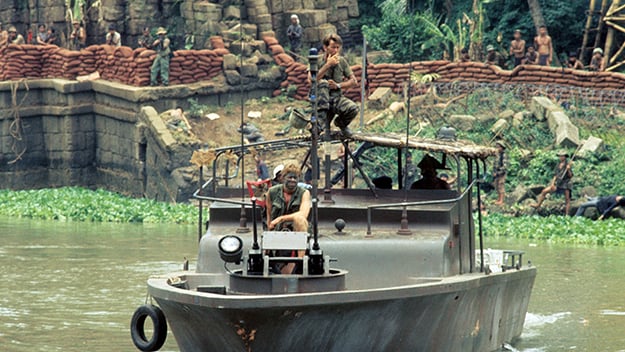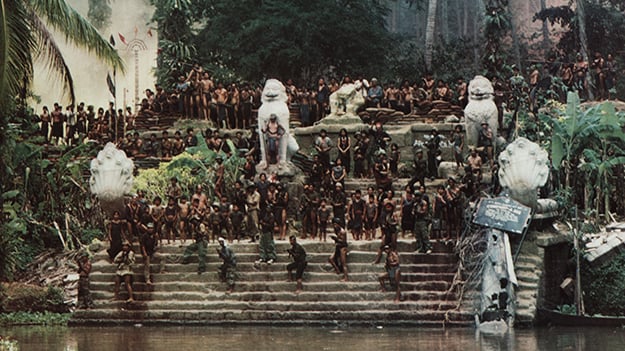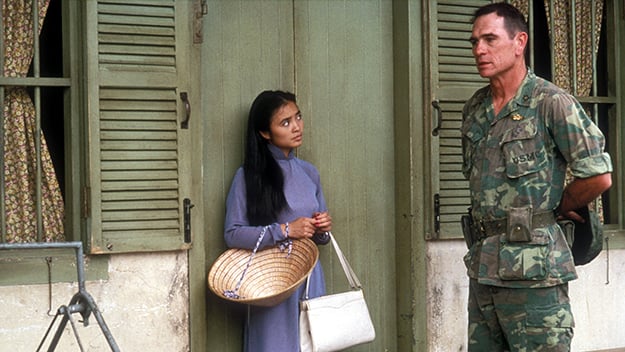Feeling Seen: Whose Apocalypse Now?
Feeling Seen is a regular column focusing on personal reflections on films from different authors and writers.

Apocalypse Now (Francis Ford Coppola, 1979)
A small moment in Apocalypse Now Redux captures the film’s ethos even better than any gruesome battle scene. During the French plantation sequence, Hubert, the owner’s son, upon hearing his family discussing their plan to remain in Vietnam, angrily stands up and… cracks an egg. Here lies the truth of all the conflicts between the West and Vietnam, he claims. “The white left, the yellow stay,” he shouts and leaves the table. It’s a ridiculous line, a bizarre simplification of Vietnam’s enduring and complex colonial history, yet the film treats it with noble respect, the camera lovingly gazing on the glistening white slowly slipping out of its shell. Much of Apocalypse Now, both the original cut and the Redux version, operates in the same way, portraying Vietnam as a spectacular but soulless backdrop for moral ruminations.
With Francis Ford Coppola’s “final cut” of Apocalypse Now making headlines at festivals, critics have been presented with an opportunity to reevaluate the legacy of the film, yet again there is familiar (and by now well-rehearsed) praise for the film’s frenzied visual feast and its legendarily difficult production. The country of Vietnam does indeed look spectacular in Apocalypse Now, but as a character, Vietnam is a body without soul. The panoramic signposts are all there—dark tropical forests, huts and rice fields—and are part of iconic images in film history. Nevertheless, despite the elaborate mise en scène, a sense of emptiness and rootlessness lingers in these frames. Vietnamese characters in the film are treated as setpieces, decorations to complete the “look” of war. They are shown as peasants running away from the American soldiers, or as maimed bodies strung over tree branches and artistically strewn on Captain Willard’s path. And they are almost never seen in close-ups—the way Western characters are instantly rendered as psychologized beings. In fact, Vietnamese voices are rarely even heard, and when they are, they are bodiless, a mere aural complement to images of graphic casualties. Their non-subtitled dialogues serve less as a cultural signifier but more as a shortcut to heighten the breach between the Americans and the “strange” land they are in.
Coppola’s artistic intentions are well-documented, the film firmly enshrined in the late New Hollywood pantheon along with its creator’s mythologized process. One thing we know, for example, is that the director specifically adapted the arrow attack sequence from Joseph Conrad’s Heart of Darkness to portray a clash between civilization and tribal primitiveness. The resulting objectification of the Montagnard—the indigenous peoples in central Vietnam who essentially function in the movie as the adoptive children of Colonel Kurtz—becomes grotesque. During the period in which the film takes place, the Montagnard, who had already been highly trained by the U.S. Army, were extremely skilled in combat; with that in mind, the arrow conceit plays as absurd and downright crude, much less the notion of their being scared away by sirens. More importantly, in contrast to their portrayal as an unworldly clan under the spell of white American generals, the Montagnard were in fact a strategic ally to the U.S. Army. Coppola, however, was enamored with fashioning an exoticizing vision of an ethnic tribe holding out against a modern war machine. The result is a kind of offensive grandeur: the Montagnard come off as larger than life precisely because they are not life-like. On screen, they are no different from the towering Filipino trees which double for Vietnamese tropical forests.

Apocalypse Now (Francis Ford Coppola, 1979)
The abandonment of historical realism in Apocalypse Now’s depiction of Vietnam becomes understandable considering that the film’s primary concern does not lie with the Vietnamese side. In truth, it does not completely fall with the side of the American soldiers either. Instead, Apocalypse Now occupies a hazy middle ground from which to ponder the Vietnam War as a testing ground for the existential struggle between good and evil, the sinners and the innocent. Near the beginning of the film, Captain Willard’s superior waxes poetic on the good and the evil within every human being, and the tragedy of Colonel Kurtz who was once a humanitarian and is now completely overcome by immorality and vainglory. This sentiment is reflected later in the French plantation scene when Madam Sarrault whispers in Captain Willard’s ears about his two selves: “one that kills and one that loves.” Apocalypse Now views Vietnam as a mythical land full of unknowable, exotic forces, implying that not just the war but the country itself possesses some power to cast the American soldiers into the dark side. In this respect, Apocalypse Now appears less of a war film than an entry in the cowboys-and-Indians tradition whereby the white protagonist must cling to the goodness of civilization in the face of pure barbaric evil. All the mesmerizing spectacle glosses over the fact that the Vietnam War was also a civil conflict between North and South, and not merely a moral encounter between the East and the West or the primitive and the civilized, a schema that helps obfuscate the political and ideological systems behind the machinations of the Vietnam War.
Apocalypse Now’s strategy of centering its narrative on a white protagonist and a good-versus-evil dichotomy has influenced many of its fictional successors such as Casualties of War and Platoon. Even Ken Burns’s 10-part 18-hour documentary series The Vietnam War, which proposes to examine the war from both sides, is equally guilty of this. Midway through chronicling the War, the series suddenly switches gear: episode three begins with the story of a fallen white American soldier, told from childhood to adulthood through his personal photographs and his family’s own words. None of the Vietnamese figures in the documentary are given the same treatment, nor is a linear account developed around any of them. It is almost as if, from the American point of view, the timeline of the Vietnamese people, both the Southern and the Northern, begins and ends with the Vietnam War. Their identities are not seen as separate entities but embedded within the tentacles of war.
After years of American directors dissecting the war, the voice of Vietnam was heard earlier in Oliver Stone’s Heaven & Earth, based on the extraordinary autobiography of Le Ly Hayslip, a Vietnamese-American humanitarian and war refugee. While Apocalypse Now begins with The Doors’ nihilistic “The End” over images of green trees suffocating under smoke bombs, Stone’s 1993 epic takes a diametrically opposite approach to its opening: seas of rice fields flow under a score of traditional Vietnamese music. Le Ly Hayslip is shown as a girl praying at her temple, harvesting rice with her parents, and watching a Vietnamese folk play with others in her village. Vietnam in Heaven & Earth is still a wartime country, but it is also full of hope and life. Here the Vietnamese are not bound together only by war but by the indestructible bond of their community.

Heaven & Earth (Oliver Stone, 1993)
At the time of Heaven & Earth’s release, many critics lamented the heroine’s passivity, not comprehending that this so-called passivity is in fact resilience, a quality with which Vietnamese identify deeply. Without resilience, Le Ly Hayslip could not have survived her ordeal of being raped, forced into prostitution, and abused at the hands of her American husband, who was supposed to be her savior. Similarly, without resilience, Vietnam could not have endured centuries of Chinese, French, Japanese, and American occupation. While Stone’s filmmaking could be seen as heavy-handed at times during the more emotional scenes, Heaven & Earth remains an anomaly among Vietnam War films in which the story is told, not only from a Vietnamese viewpoint, but also through a woman’s experience.
The Vietnam War was singular at the time because of its extensive televisual documentation: it was the first war to be broadcast up close, in color, and while it was happening. The most famous photos of the Vietnam War are not of heroic combat or victories but of the atrocities that were committed and the suffering that occurred on both sides of the battle. As a result, the nature of this war is collectively recognized to be ideologically destructive. Looking at Apocalypse Now today through clear eyes raises the question: barring something like Heaven & Earth, is the Vietnam War the kind of event that ultimately resists the traditional subjective interpretation of Western auteur cinema? When placed side by side with the documented reality of the war, which reveals a complex structure of political forces at work, a director’s attempt at theologizing and thematizing Vietnam into a single united auteurist vision risks coming off as inauthentic and simplistic.
All of this, like the Vietnam War itself, is not news—Vincent Canby called Apocalypse Now a “profoundly anticlimactic intellectual muddle” in his 1979 New York Times review—but the need for a reckoning remains no less urgent. Recognizing the forces and facts in play pushes the audience to look beyond Apocalypse Now’s canonical idolization and instead critically and empathetically re-evaluate the historically and politically befuddled landscape in which Coppola’s auteurist aesthetics operates. While the legacy and the filmmaking of Apocalypse Now will continue to influence cinema for years to come, the least we could hope for the next U.S.-produced Vietnam War movie is that, even if the story is told from a Western perspective, it will come from an underrepresented American voice—one that, like the Vietnamese point of view, is rarely heard in the numerous filmic presentations of the war.
Phuong Le is a freelance film critic. She grew up in Vietnam and studied film in the U.S. and the U.K.







